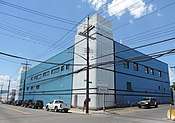Visual pollution
Visual pollution is an aesthetic issue and refers to the impacts of pollution that impair one's ability to enjoy a vista or view. Visual pollution disturbs the visual areas of people by creating harmful changes in the natural environment. Billboards,[1][2] open storage of trash, antennas, electric wires, buildings, and automobiles are often considered visual pollution. An overcrowding of an area causes visual pollution. Visual pollution is defined as the whole of irregular formations, which are mostly found in nature.[3][4]
Effects of exposure to visual pollution include: distraction, eye fatigue, decreases in opinion diversity, and loss of identity.[5] It has also been shown to increase biological stress responses and impair balance [6]
Sources

Local managers of urban areas sometimes lack control over what is built and assembled in public places. As businesses look for ways to increase the profits, cleanliness, architecture, logic and use of space in urban areas are suffering from visual clutter.[7] Variations in the built environment are determined by the location of street furniture such as public transport stations, garbage cans, large panels and stalls. Insensitivity of local administration is another cause for visual pollution. For example, poorly planned buildings and transportation systems create visual pollution. High-rise buildings, if not planned properly or sufficiently, can bring adverse change to the visual and physical characteristics of a city, which may reduce said city's readability[8]
A frequent criticism of advertising is that there is too much of it.[9] Billboards, for example, have been alleged to distract drivers, corrupt public taste, promote meaningless and wasteful consumerism and clutter the land.[10] See highway beautification. However, with the introduction of new communication technologies, the fragmentation and incentive nature of advertising methods will improve, reducing clutter. Thus, with the increase of mobile device usage, more money goes to advertising on social media websites and mobile apps. Vandalism, in the form of graffiti is defined as street markings, offensive, inappropriate, and tasteless messages made without the owner's consent.[11] Graffiti adds to visual clutter as it disturbs the view.
Prevention
United States
In the United States, there are several initiatives gradually taking place to prevent visual pollution. The Federal Highway Beautification Act of 1965 limits placement of billboards on Interstate highways and federally aided roads. It has dramatically reduced the amount of billboards placed on these roads.[12] Another highway bill, the Intermodal Surface Transportation Efficiency Act (ISTEA) of 1991 has made transportation facilities sync with the needs of communities. This bill created a system of state and national scenic byways and provided funds for biking trails, historic preservation and scenic conservation.[13]
The Dunn Foundation is an organization that increases public awareness of visual pollution and landscape appearance in America through educational programs.[14] The foundation has designed an educationally interactive package for students from grades 3-12 on how to improve the visual environment in their communities. Another company working toward prevention of visual clutter is Scenic America; a non-profit organization that envisions a future movement toward ensuring that scenic conservation boosts the economy and decreases visual pollution.[15] Businesses situated near an interstate can create problems of advertising through large billboards, however now an alternative solution for advertisers is gradually eliminating the problem. For example, logo signs that provide directional information for travelers without disfiguring the landscape are increasing and are a step toward decreasing visual pollution on highways in America.[16] Thus, researchers believe that planners should help and encourage citizens to maintain their communities as citizens have the power to influence government, especially local and regional management where most issues regarding appearance are disclosed.
Brazil
In September 2006, São Paulo passed the Cidade Limpa (Clean City Law), outlawing the use of all outdoor advertisements, including on billboards, transit, and in front of stores.[17]
See also
- Clutter (marketing)
- Eyesore
- Light pollution
- Noise pollution
- Cidade Limpa
References
- Chmielewski, Sz., Lee, D., Tompalski, P., Chmielewski, T., J., Wężyk, P. (2016) Measuring visual pollution by outdoor advertisements in an urban street using intervisibility analysis and public surveys. International Journal of Geographical Information, 30(4): 801-819. DOI: 10.1080/13658816.2015.1104316 (https://www.researchgate.net/publication/283491169_Measuring_visual_pollution_by_outdoor_advertisements_in_an_urban_street_using_intervisibilty_analysis_and_public_surveys/)
- Chmielewski, S., Samulowska M., Lupa, M., Lee, D., Zagajewski, B., (2018) Citiezen Science and WebGIS for outdoor advertisement visual pollution assessment. Computers, Environment and Urban Systems (67): 97-109 (https://www.researchgate.net/publication/320086937_Citizen_science_and_WebGIS_for_outdoor_advertisement_visual_pollution_assessment)
- Yilmaz, Demet (May 2011). "In the Context of Visual Pollution: Effects to Trabzon City Center Silhoutte". The Asian Social Science Journal. 7 (5): 99. ProQuest 866420567.
- Nagle, Copeland. (2009). Cell Phone Towers as Visual Pollution. Notre Dame Journal of Law, Ethics and Public Policy.
- Yilmaz, Demet (May 2011). "In the Context of Visual Pollution: Effects to Trabzon City Center Silhoutte". The Asian Social Science Journal. 7 (5): 99. ProQuest 866420567.
- Wibble, T., Södergård, U., Träisk, F., Pansell, T. (2020) Intensified visual clutter induces increased sympathetic signalling, poorer postural control, and faster torsional eye movements during visual rotation (https://journals.plos.org/plosone/article/metrics?id=10.1371/journal.pone.0227370)
- Morozan, Cristian; Enache, Elena; Purice, Suzan. "Visual Pollution: A New Axiological Dimension Of Marketing?" (PDF). University of Pite, Faculty of Management-Marketing in Economic Affairs Brilla. Retrieved 29 March 2013.
- Yilmaz, Demet (May 2011). "In the Context of Visual Pollution: Effects to Trabzon City Center Silhoutte". The Asian Social Science Journal. 7 (5): 99. ProQuest 866420567.
- Morozan, Cristian; Enache, Elena; Purice, Suzana. "Visual Pollution: A New Axiological Dimension Of Marketing?" (PDF). University of Pite, Faculty of Management-Marketing in Economic Affairs Brilla. Retrieved 29 March 2013.
- Nagle, Copeland. (2009). Cell Phone Towers as Visual Pollution. Notre Dame Journal of Law, Ethics and Public Policy.
- Morozan, Cristian; Enache, Elena; Purice, Suzana. "Visual Pollution: A New Axiological Dimension Of Marketing?" (PDF). University of Pite, Faculty of Management-Marketing in Economic Affairs Brilla. Retrieved 29 March 2013.
- Nagle, Copeland. (2009). Cell Phone Towers as Visual Pollution. Notre Dame Journal of Law, Ethics and Public Policy. Retrieved from
- Maguire, M., Foote, R., & Vespe, F. (1997). Beauty as well as bread. American Planning Association.Journal of the American Planning Association, 63(3), 317-328. Retrieved from http://search.proquest.com/docview/229617956
- "Visual Pollution". The Dunn Foundation. 2012. Archived from the original on June 2, 2013. Retrieved April 2, 2013.
- "Seven Principles of Scenic Conservation". Washington, DC: Scenic America. Retrieved April 2, 2013.
- Maguire, M., Foote, R., & Vespe, F. (1997). Beauty as well as bread. American Planning Association.Journal of the American Planning Association, 63(3), 317-328. Retrieved from http://search.proquest.com/docview/229617956
- "Five Years After Banning Outdoor Ads, Brazil's Largest City Is More Vibrant Than Ever". The Center for a New American Dream. Retrieved September 26, 2013.
- Chmielewski, Sz., Lee, D., Tompalski, P., Chmielewski, T., J., Wężyk, P. (2016) Measuring visual pollution by outdoor advertisements in an urban street using intervisibility analysis and public surveys. International Journal of Geographical Information, 30(4): 801-819. DOI: 10.1080/13658816.2015.1104316
